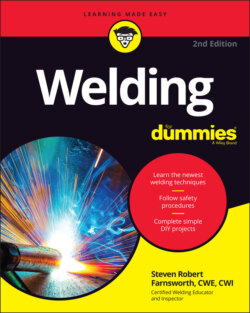Читать книгу Welding For Dummies - Steven Robert Farnsworth - Страница 33
Preparing steel for welding
ОглавлениеAll metals have to be cleaned and prepared before you weld them, and steel is definitely no exception. Quality welds aren’t going to happen if your steel is covered with surface contaminants. And some of those contaminants can be downright dangerous to your health if they’re heated up and converted to fumes while you’re welding. (Flip to Chapter 3 to read all about the safety gear you can get to protect yourself from fumes.)
You especially need to do your best to remove rust from the surface of your steel. Rust is especially common on mild steel (covered earlier in this chapter), and it can wreak havoc when you’re trying to produce a high quality weld. The most common defect you experience as a result of rust is porosity (the presence of lots of little holes) in your welds, and porosity can really ruin a good weld joint.
If you want to use a steel that’s less prone to rusting, try one that has a little chromium added to it. Chromium slows down corrosion processes in steel. You can also try weathered steel, which has a copper alloy in it and holds up well outdoors.
You can use one of two methods for cleaning your steel prior to welding: chemical or mechanical. The method you choose depends on the metal type, the condition of the metal, the welding process you’re planning to use, and the equipment available.
Don’t assume that a piece of steel (or any metal for that matter) is clean just because it looks clean. Even a new piece of steel fresh from your welding supply store has contaminants on the surface that you need to clean off prior to welding.
